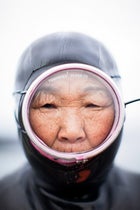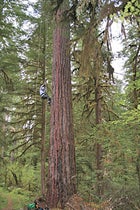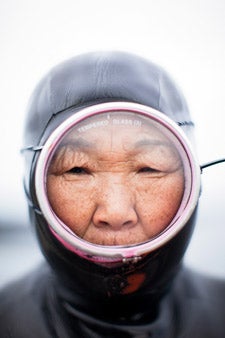Old Women of the Sea
Korean haenyeo
 Your Korean dive master
Your Korean dive masterFreediving with mermaids in South Korea
I’m about to have my ass handed to me by a gang of Korean grandmothers with painted-on eyebrows. It’s a raw morning in the village of Hado, on the eastern coast of South Korea’s Jeju Island, and I’ve come to visit these haenyeo (literally “women of the sea”) to get a lesson in the art of freediving. A cold drizzle has me on edge, but the ladies seem not to notice. “Don’t you want to dive with us?” one sweet 72-year-old asks. The truth is, with the rain ratcheting up and the East China Sea hovering around 58 degrees, I can’t think of anything I’d rather do less.
For the women of Jeju, diving is life. They took up freediving in the 17th century to support their families because their sailor husbands were frequently lost at sea. They harvest abalone, conch, octopus, urchin, and seaweed. And though the trade is dwindling as young girls find easier livelihoods, Jeju still has about 5,000 working haenyeo.
Fighting back my anxiety, I pry on my wetsuit and clamber into the water alongside the ladies. My hands go numb and the cold stings my face as we swim. By the time the divers stop, we’re a half-mile offshore. Kelp shrouds the seafloor in a thick carpet of crimson and thrusts upward in ropy vines that surge with the waves. The haenyeo kick down 40 feet to the seabed to cut abalone from the rocks with sharp metal hooks. One minute passes, sometimes two, before they stream to the surface. They stay above water for only a minute or so between descents, chatting and smiling, seemingly oblivious to the rolling waves. They could be plucking tomatoes.
I try finning down, but by the time I reach the bottom my lungs burn. I panic, surface, and just watch, amazed. After an hour, I’m freezing, so I fight the waves back to land, where I wait under my umbrella, feeling like a pansy. Finally, four hours later, the haenyeo begin floating in one by one, their nets bulging. The women lead me into their stone warming hut. Once they’ve built a fire, they press whole abalone into my mouth as they clean their haul. The haenyeo may be tougher than walrus hide, but they’re still grandmothers at heart.
DO IT:
flies daily from Seoul to Jeju City. The haenyeo don’t offer guided trips, but with some wrangling you might convince them. NAUI-certified Big Blue 33 operates dive trips out of Sogwipo City, on the southern coast of Jeju. Two-tank dives, $65;
Elevated
Kissing the sky in Oregon
Oregon Tree Climbing
 Getting high with the Pacific Tree Climbing Institute
Getting high with the Pacific Tree Climbing InstituteWhen I was a kid, I watched Swiss Family Robinson so many times that the VCR expelled the tape in a tangle. When I was a kid, I escaped into a tree after peeing on my sister and spent the entire day in its upper reaches until, starved, I came down to face my spanking. When I was a kid, I hammered together an unwieldy tree house overlooking a highway and collected a pile of stones to slingshot at passing cars.
A significant portion of my childhood, in other words, was spent up in the air, defying the laws of gravity and parents. So it feels perfectly natural when I seek out the Pacific Tree Climbing Institute, based in Eugene, Oregon. My guides work as arborists during the week and lead climbs over the weekend. I meet them at the base of a 250-foot, 500-year-old Douglas fir in the Willamette National Forest. They don’t supply me with spurs—only a helmet, gloves, and a harness that links me to a rope attached to the crown of the tree. With two ascender clips, I inchworm upward, my body spinning in the air.
At 150 feet, the branches begin to claw at my arms. For the next hour I snake my way up until I reach the top, where I sway in my roost and take in the sunset, then switch over to my descender clips and sink down to where the hammocks wait. My voice joins the owls calling all around me when I wish my guides goodnight and fall into dreams on this ultimate air mattress.
DO IT: Day climb plus an overnight in a hammock, $600; .
A Stroll in the Park
On patrol in rhino country with the Kenya Wildlife Service
According to my guidebook, black rhinos charge out of fear, confusion, and panic. This happens frequently, due to their terrible eyesight. They have been known to charge tree trunks and termite mounds. I ask Karanja, the Kenya Wildlife Service officer I am following across the dusty thornlands of Tsavo West, a 3,500-square-mile national park in east Kenya, what the plan is in the event the rhino we are tracking charges. “You can dodge them easily,” he says, glancing at his transceiver, which he hopes will lead us to our subject. I hustle to keep up with his giant marathoner strides and think, What about the lions?
Photographer Kevin Arnold and I arrived here on assignment with a high-end safari company, but after a few days rattling around the desert in the van, dodging identical tourist vehicles, we realized we’d have to dig harder for a unique experience. We forced our poor driver to take us to park headquarters, where, interviewing the head warden, we asked if there were opportunities to accompany rangers on their scientific rounds. In fact, he said, there was just such a pilot program for tourists. Striking out cross-country on foot—normally a taboo practice here—sounded exciting. But it’s starting to feel like the time I embedded with a police unit and ended up helping arrest a meth addict who had a homemade bomb duct-taped to his hand.
Instead of finding the rhino—the transceiver turns out to be broken—we stumble upon eight frisky lion cubs, all of whom are delighted to see us, and two lionesses, who aren’t. You have no idea how loud a lion’s roar is until it’s directed at you. “Just keep walking,” says Karanja, his stride lengthening as we veer directly up a hill. The lionesses stand down. Karanja has had closer calls, he says later over a beer, with the assurance of a man who has it all under control. I ask him how many other people have gone out with him on this program. “You are the first,” he says.
DO IT: The Ngulia Rhino Sanctuary, in Tsavo West National Park, allows volunteers to help with the full-moon rhino census in exchange for donations to the program. .




